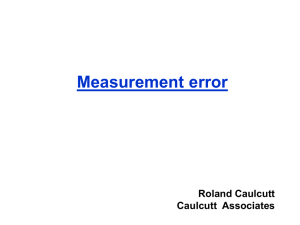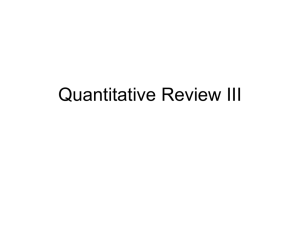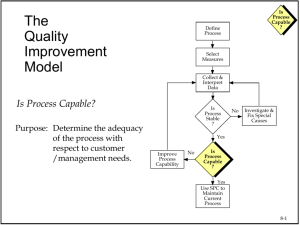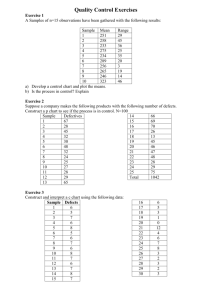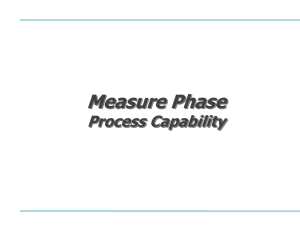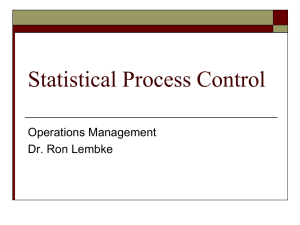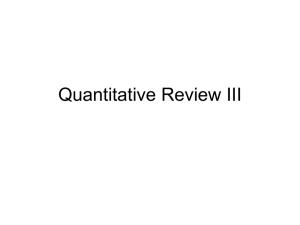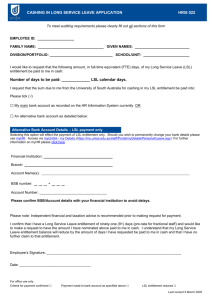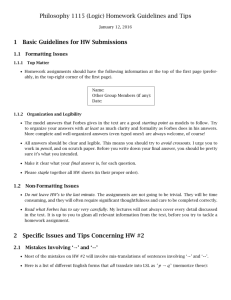PRODUCTIONS/OPERATIONS MANAGEMENT
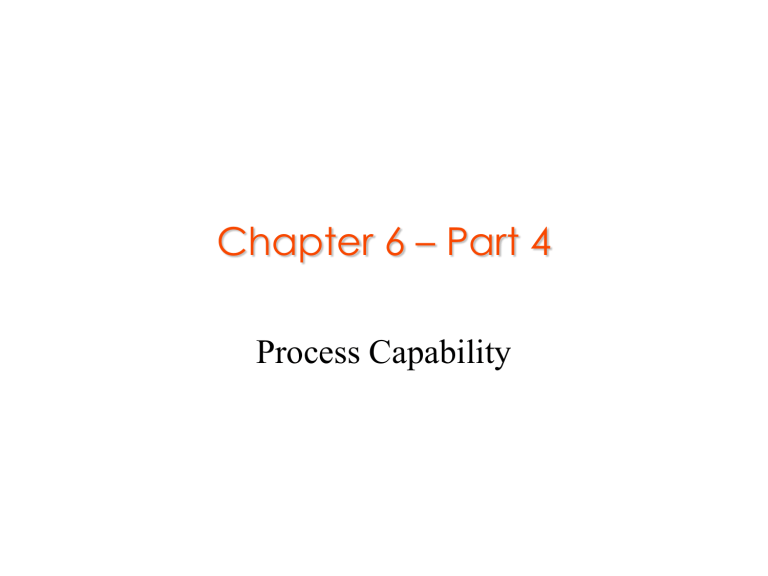
Chapter 6 – Part 4
Process Capability
Meaning of Process Capability
The capability of a process is the ability of the process to meet the specifications.
A process is capability of meeting the specification limits if at least 99.73
% of the product falls within the specification limits.
This means that the fraction of product that falls outside the specification limits is no greater than
0.0027, or that no more that 3 out of 1,000 units is
“out of spec.”
Our method of computing process capability assumes that the process is normally distributed.
Control Limits vs. Spec. Limits
Control limits apply to sample means, not individual values.
Mean diameter of sample of 5 parts, X bar
Spec limits apply to individual values
Diameter of an individual part, X
Control Limits vs. Spec. Limits
Sampling distribution,
X-bar
Process distribution,
X
LSL
Lower control limit
Mean=
Target
Upper control limit
USL
Requirements for Assessing
Process Capability
To assess capability of a process, the process must be in statistical control.
That is, all special causes of variation must be removed prior to assessing capability.
Also, process performance characteristic
(e.g., diameter, bake time) must be normally distributed.
C p
Index
Cp
USL
6
ˆ
LSL
USL = upper specification limit
LSL = Lower specification limit
ˆ estimated process standard deviation
C p
Index
6
ˆ spread of the process
USL - LSL
width of the spec.
limits
• We want the spread (variability) of the process to be as ???
• If the spread of the process is very ????, the capability of the process will be very ????
C p
Index
LSL X
Width of spec limits = USL - LSL
USL
Spread of Process = USL - LSL
Process distribution,
X
Process is Barely Capable if Cp = 1
.9973
.00135
.00135
LSL USL
X
X
Spread of process matches the width of specs.
99.73% of output is within the spec. limits.
Process Barely Capable if Cp = 1
spec. limits?
LSL =
USL =
Process Barely Capable if Cp = 1
Cp
X
USL
6
ˆ
LSL
3
6
ˆ
( X
3
)
X
6
6
ˆ
3
6
ˆ
X
1
3
Process is Capable if Cp > 1
>.9973
< .00135
USL
< .00135
X
LSL X
Spread of process is less than the width of specs.
More than 99.73% of output is within the spec. limits.
Process is Not Capable if Cp < 1
< .9973
> .00135
> .00135
LSL USL
X
X
Spread of process is greater than the width of specs.
Less than 99.73% of output is within the spec. limits.
Estimating the Standard Deviation
LCL
X
3
ˆ n
UCL
X
3
ˆ n
LCL
X
A
2
R
UCL
X
A
2
R
Estimating the Standard Deviation
3
ˆ n
A
2
R
ˆ
A
2
R
3 n
Sugar Example Ch. 6 - 3
Day Hour X1 X2 X3 X
1 10 am 17 13 6 36/3 =12
1 pm 15 12 24 51/3 =17
4 pm 12 21 15 48/3 =16
2 10 am 13 12 17 42/3 =14
1 pm 18 21 15 54/3 =18
R
11
12
9
5
6
4 pm 10 18 17 45/3 =15
X = 92/6
= 15.33
8
R = 51/6
= 8.5
R
8 .
5 , n
3 , A
2
1 .
02
ˆ
A
2
R
3 n
( 1 .
02 )( 8 .
5 )
3
15 .
0169
3
5 .
0
3
Capability of Sugar Process
USL = 20 grams
LSL = 10 grams
ˆ
5 .
0
Cp
USL
6
ˆ
LSL
20
10
6 ( 5 )
10
30
0 .
33
Capability of Sugar Process
Since C p
<1, the process is not capability of meeting the spec limits.
The fraction of defective drinks (drinks with either too much or not enough sugar) will exceed .0027.
That is, more than 3 out of every 1000 drinks produced can be expected to be too sweet or not sweet enough.
We now estimate the process fraction defective, p -bar.
Estimated Process Fraction Defective
What is the estimated process fraction defective -the percentage of product out of spec?
p -bar = F1 + F2
F1
LSL USL
F2
Mean
Estimated Process Fraction Defective
We can then use Cp to determine the p -bar because there is a simple relationship between Cp and z : z = 3 C p
(See last side for deviation of this result.)
•
Suppose, C p
= 0.627
z = 3(0.627) =1.88
Estimated Process Fraction Defective
The z value tells us how many standard deviations the specification limits are away from the mean.
A z value of 1.88 indicates that the USL is 1.88 standard deviations above the mean.
The negative of z , -1.88, indicates that the LSL is
1.88 standard deviations below the mean.
We let
Area( z ) be the area under the standard normal curve between 0 and z .
Process Fraction Defective
Area( z ) = Area(1.88) = 0.4699
LSL USL
F
2
0 z = 1.88
F
2
= % above USL = .5000 - 0.4699 = .0301
.
.
0.2
.09
1.8
z
0.0
0.1
z Table (Text, p. 652)
.00
.01
.02
.
.
.
.08
.09
.4699
Process Fallout pbar = 2[.5 – Area( z )] = F1 + F2
F1
LSL
0
0.4699
USL z = 1.88
F2 pbar = 2(.5 – .4699) = 2(.0301)=.0602
Process Fallout – Two Sided Spec.
Cp
0.25
z = 3 Cp Fallout =
2[.5 – Area(z)]
Defect Rate in
PPM (parts per million)
0.75
2[.5-.2734] = .4532 453,200 PPM
0.80
1.0
1.5
2.40
2[.5-.4918] = .0164
16,400 PPM
3
-4.5
From
Excel
2[.5-.4987] = .0026
2,600 PPM
7 PPM 2[Area(z )]=
2[.0000034]
=.0000068
Recommended Minimum Cp
Process Cp z = 3 Cp
Existing process
New process
1.25
3.75
Fallout
2[Area(-z)]=
2[.000088]
=.0001769
1.45
4.35
2[Area(-z)]=
2[.000006812]
=.0000136
PPM
176.9
13.6
Recommended Minimum Cp
Process Cp z = 3 Cp
Safety, existing process
Safety, new process
Fallout
1.45
4.35
2[Area(-z)]=
2[.000006812]
=.0000136
1.60
4.80
2[Area(-z)]=
2[.000000794]
=0.0000016
PPM
13.6
1.6
Soft Drink Example
Cp = 0.33
z = 3 Cp = 3(0.33) = 0.99
Area( z ) = Area(0.99) = 0.3389
p -bar = 2[.5 - Area(0.99)]
= 2[.5 - 0.3389]
= 0.3222
Capability Index Based on Target
• Limitation of C p is that it assumes that the process is mean is on target.
Process Mean = Target Value = (LSL + USL)/2
C
T
Capability Index
With Cp, capability value is the same whether the process is centered on target or is way off.
Cp is not affected by location of mean relative to target.
We need capability index that accounts for location of the mean relative to the target as well as the variance.
C
T is an index that accounts for the location of mean relative to target.
C
T
Capability Index
C
T
6
USL
LSL
ˆ
( X
Target)
2
C
T
Capability Index
If process is centered on target,
X
Target
( X
Target)
2
0
C
T
??
If process is off target,
X
T arget
C
T
C p
Example of C
T
LSL = 10, USL = 20, estimated standard deviation =
5.0 and estimate process mean = 15.33. Compute
C
T
.
C
T
6
USL
LSL
ˆ
( X
Target)
2
6
20
10
5
( 15 .
33
15 )
2
.
3326
C
T
Capability Index
If process mean is adjusted to target,
C
T
6
USL
LSL
ˆ
( X
Target)
2
6 0 .
3
14
10
( 12
12 )
2
2 .
2
C p
C
T
Capability Index
C p is the largest value that C
T can equal.
Since C p
= 2.2 and C
T
= .44, the difference
D
C p
C
T
.
3333
.
3326
0 .
0007 is the maximum amount by which we can increase
C
T by adjusting the mean to the target value.
Conclusion?
Derivation of z = 3Cp
C
p
X
2 z
ˆ z
6
ˆ
USL z
ˆ
6
ˆ
(
6
ˆ
LSL
X
3 z
ˆ
) z
3 C p
